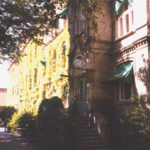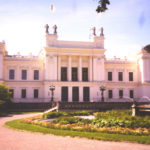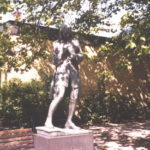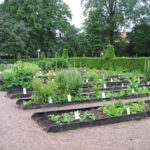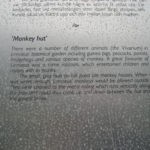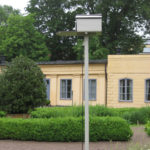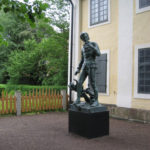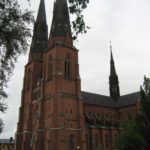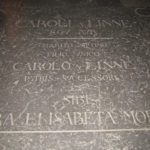Sweden
Sweden, on the Baltic Sea, has a long tradition of excellence in a variety of human endeavors, and is today certainly one of the most socially advanced countries in the world. Time and time again, one is struck with the wealth of scientific ideas which originate in Sweden, and the Swedes continue to maintain incredibly high standards. We cannot refrain from pointing out that this state of affairs is at least in part due to the fact that they have managed to keep their population small and more or less stable, and also to have stayed out of any major war for nearly 200 years!
LUND
Location – 625 kilometers southwest of Stockholm. 20 kilometers northeast
of Malmö.
Train – From Stockholm and Malmö direct.
Road – From Stockholm take the E4 to the south, and at Helsingborg join
the E6 to Lund and Malmö. From Malmö take route 15 to the north.
Lund was founded in 1020 by no less a person than King Canute (d. 1036), and subsequently became the religious, cultural, political and commercial center for much of Scandinavia. However, today Lund is a university town, which attracts our interest here, particularly because of its proximity to Malmö, which for many visitors will be their first point of contact with Sweden. A good way to get to Malmö is on the hydrofoil from Copenhagen, Denmark.
The University of Lund was founded in 1668. At first there was only a Faculty of Theology, but law and medicine soon followed. Today there are over 100 departments and about 20,000 students. Most of the present buildings date from the 19th century, the main building being in a park just off the Kyrkogatan. By application here, it is possible to get a walking tour of the university, but there is no regular schedule.
Of great interest is a lovely bronze status of Carl Linnaeus (see picture) in Petri Park, which is at the corner of Petri Kyrkog and Bredgatan. Linnaeus studied medicine at Lund, but only for one year. In addition the visitor should not miss the University Apotek, a pharmacy dating from 1627. It is in the Kyrkogatan, and easily recognized by the pharmacist’s symbol of a carved swan. Finally visitors will want to see the cathedral in the main square, with its huge medieval clock which tells the time, the date, the course of the sun and moon, etc. It is really quite an event when it chimes at noon!
STENBROHULT
Location – 475 kilometers southwest of Stockholm, and 150 kilometers
northeast of Malmö.
Train – From Stockholm or Malmö to Växjö and then by bus or taxi to
Stenbrohult.
Road – From Stockholm take the E4 south to Huskvarna, and then fork ontoroute 30 to Växjö. Then take route 23 towards Almhult, but before
reaching Almhult turn off to Stenbrohult. From Malmö take route 23 towards Växjö, but shortly after Almhult turn off to Stenbrohult.
Stenbrohult is a small village southwest of Växjö, and it was
here in 1707 that Carl Linnaeus (see under Uppsala) was born. His birthplace and other associations are well preserved.
Rashults Sodergard
Stenbrohult
Opening hours:
Daily, 9.00 – 17.00
Small charge for admission.
This is an estate on the outskirts of Stenbrohult, which comprises several acres preserved as a part and contains the cabin where Linnaeus was born.
The whole estate is preserved much as it was in Linnaeus’ day, and there are many interesting things to be learned about Swedish rural life in the early 18th century. This is true also of the Linnaean cabin, which was carefully restored in 1935. Inside the cabin, even the wallpaper is original from the 18th century, as is also the sparse furniture. Some of the furniture belonged to Linnaeus himself, and there are many cases containing some of his personal belongings and other mementos. There are also several original portraits of him done at various times in his life. The kitchen, with its open hearth and gray stone floor is original. There is also a loft containing costumes, furniture, utensils, etc. of the period. Just outside the house is an enclosed garden which is a replica of the one laid out by Linnaeus’ father. Its accuracy to the original was confirmed by Carl’s brother, who succeeded his father as vicar of Stenbrohult, and Carl himself visited the garden in 1731.
In Stenbrohult proper, the main associations with Linnaeus are in the grounds of the church, which border on a lake. Carl’s father, Nicolaus, was the vicar here beginning in 1706. Just two years after Carl was born, the family moved to the new vicarage close to the church, and in these beautiful surroundings Carl spent many childhood years. Unfortunately the vicarage was destroyed by fire in 1720, and only the foundations survive. However, Linnaeus’ close association with the area is commemorated by a very lovely statue of him as a young man.
Stenbrohult is an “out of the way” place, but well worth a visit by those interested in the history of botany.
UPPSALA
Location – 70 kilometers northwest of Stockholm.
Train – Direct from Stockholm.
Road – From Stockholm take the E4 to Uppsala.
Uppsala is a very ancient city, astride the river Fyris. It is the metropolitan sea of the Swedith State Church, with a magnificent Gothic cathedral built between 1230-1435. The university was founded in 1477. Uppsala is of special interest to us, because it was here that Carl Linnaeus lived and worked for most of his life.
Carl Linnaeus (1707-1778) was born in Stenbrohult (see above), the son of the local parson. His father had a deep love of all things natural, but particularly of flowers and gardening, and he passed this love onto young Carl who embraced it for the rest of his life. He attended the cathedral school in nearby Växjö, intending at first to become a parson. However, his interest in botany was so strong that he soon abandoned theology. At that time the road to botany was through medicine and at 20 he entered the University of Lund to study this, and a year later transferred to Uppsala. In all it took him 8 years to get his medical degree, eventually from the University of Harderwijk in Holland in 1735. This was simply due to the fact that he was always botanizing instead of studying medicine!
While a student at Uppsala, Linnaeus immersed himself in botany, and developed the basis of what was to become his system of the classification of all living things. He was one of the first people to recognize plant sexuality, and he based his classification of these on their pistils and stamens. At the same time he developed the concept of what we now call the binomial nomenclature, which is the basis of all modern classification. It is important to note that Linnaeus had no thought of organic evolution as we know it today, but his system of classification has been adopted for the naming of plants and animals in their evolutionary relationships.
In 1735 Linnaeus left Uppsala and traveled extensively in France, Holland and England. In the same year at the early age of 28, his monumental work “systema Naturae” (The System of Nature) was published in Leiden, Holland. Although he had published many works on botany before, this quickly established him as the leading botanist of the world. In 1738 he returned to Sweden, married Elizabeth Moraea, and for a time set up medical practice in Stockholm, before being appointed professor of medicine in Uppsala. However, things were arranged so that he could devote most of his time to botany. For the rest of his life, Linnaeus remained at the University of Uppsala studying and writing about botany. His output, particularly on the flora of Sweden, was enormous, but it may safely be said that his reputation as the foremost botanist of all time rests on the new concepts of classification which he put forth in his “Systema Naturae.” He died in Uppsala in 1778, and is buried in the cathedral.
Linnémuseet
Svartbäcksgatan 27
Uppsala
Opening hours:
Museum, Tuesday – Sunday 13.00 – 16.00
Garden, Tuesday – Sunday 9.00 – dusk.
Both closed Mondays.
Small charge for admission.
This is the Linnaen museum and garden in Uppsala. The garden dates from 1635, and was the original botanic garden of the university. When Linnaeus came to Uppsala as a professor of medicine in 1741 he took over responsibility for the garden, and lived in the house which went with the position. Under Linnaeus’ direction, the gardens were greatly improved and laid out in baroque style. Of great interest also is the fact that he arranged the plants according to his newly developed sexual system. Today we would call this a taxonomic garden, and this is certainly the oldest such garden in the world. After Linnaeus’ death the garden fell into decay, but fortunately he left an exact description of it in his Hortus Uppsaliensis (1745), and when the garden was restored in 1917 by the Swedith Linnaen Society, Linnaeus’ original plan was faithfully followed. Thus the visitor today can see and walk in this same garden which Linnaeus himself laid out.
The adjoining house, in which Linnaeus lived for many years is now the Linnaen Museum. When Linnaeus died in 1778, almost all of his huge collections of plants and animals, as well as his library, letters and manuscripts, were sold at public auction in Stockholm. The highest bidder was a young wealthy English medical student, James Edward Smith, and in due course he shipped the collections to London where they became the basis of the Linnaen Society of London (see under London). However, Linnaeus’ household effects remained in the hands of his family, and were returned to the house in 1935 when it was restored as a museum. It is in fact exceptionally well stocked, and everything in it belonged either to Carl Linnaeus himself or his family. There is no doubt it is much the same as Linnaeus would have known it. There is a wealth of furniture, clothes, utensils, tec., also many of Linnaeus’ instruments, notebook, published books, portraits of him, etc., all beautifully kept and displayed. Finally there is a nice bronze statue of him in the courtyard entrance to the museum.
Carolina Rediviva
Drottninggatan and Dag Hammarskjölds Vag
Uppsala
Opening hours:
Daily, but times vary considerably.
No charge for admission.
This is the University Library, and the largest library in Sweden.
Of great interest to us, however, is the Linnaen collection housed in a special room. It is not normally open to the public, but permission to see it can be requested from the librarian. It is without doubt the most extensive Linnaen collection in the world, but unfortunately without Linnaeus’ own library (see under London).
In public areas of the library are displays, under glass, of some priceless old books and maps. One of these is the Codex Argenteus or Silver Bible. It was probably written in Ravenna, Italy about 500 A.D. It is composed of purple vellum with silver and gold letters. A most remarkable sight!
Gustavianum
Uppsala
Opening hours:
Monday – Friday, 8.00 – 16.00.
No charge for admission.
This is a unique anatomy theatre located in the main square of Uppsala just behind the cathedral. It was built in 1663, and was a copy of the anatomy theatre in Padua, Italy (see under Italy) of the previous century. It was a gift of the University of Uppsala from one of its professors, Olof Rudbeck (1630-1702), who, in 1650 when only 19 years old, discovered the lymph system – no mean achievement! The theatre is all hand carved wood, very lovely, and the second oldest in the world.
Domkyrkan
Uppsala
Opening hours:
Variable – must inquire locally.
This is an active church.
The Cathedral of Uppsala, located in the center of the city, took some 200 years to build, and was completed in 1435. It is the largest church in Scandinavia. From our point of view, however, all biologically minded visitors will want to visit it to see the tomb of Carl Linnaeus.
Linnaeus’ Hammarby
Uppsala
Opening hours:
Buildings, daily 12.00 – 16.00
Grounds, daily 8.00 – dusk.
Small charge for admission.
This is the former country house and farm of Linnaeus. It is about 10 kilometers south of Uppsala and can be reached by a local, but infrequent, bus from the station. It is best however, to take a taxi if possible. Linnaeus purchased the farm in 1758, and it remained in family hands until 1879 when it was purchased by the state as a permanent memorial to Linnaeus. The main building was Linnaeus’ house where he lived with his family. It is quite spacious and well maintained much as it was when Linnaeus lived there. It is well stocked with furniture, portraits, books, etc., and in some rooms the walls are papered with prints of his plant illustrations and drawings. The outside of the building has been boarded over, which is a pity, but apparently necessary to preserve the original logs.
The grounds and adjoining woods are a joy to wander in, particularly in spring. Here Linnaeus “cultivated his garden” and introduced so many new species of plants. There is indeed little doubt that the columbines and lilies, which flourish in the woods, are direct descendants of those which Linnaeus planted himself. It is a truly thrilling experience to spend a few hours at this beautiful place and celebrate the memory of the world’s great botanist. It is also a fitting and pleasant place to end our account of Sweden.

